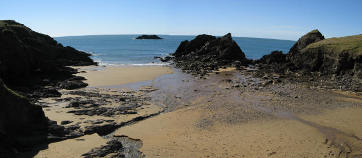MEETINGS 2019
"SCRATCH - A SALCOMBE BOY"
Billy "Scratch" Hitchen
In February, Billy “Scratch” Hitchen came along to tell us about his fascinating life and his recent autobiography.
Hating school (when he bothered to attend!), Scratch ran away to sea aged 14, signing on as cabin boy on SY Norian, which had called into Salcombe Harbour for repairs on a passage from Scotland to London. Little did he know then that he had started a journey which, in the next 45 years, would take him through tempest, typhoon, hurricane, calms, fogs, snows and close to shipwreck and see him rise from cabin boy to skipper. By the time he was 19, he had sailed round the world five times.
Finally returning home in 1973, he spent the next three decades fishing in every sea area from Dover to Rockall.
His book, “Scratch – A Salcombe Boy”, took him five years to write, without reference to any written document or diary, and he told us that the first draft, in impeccable hand-written capital letters, was one enormous sentence, with no full stops or other punctuation! Luckily, his sister Sylvia offered to type and edit it for him and it was further tidied up by Jenny Brown before publication. He took an Instamatic camera with him on his travels and brought back some lovely photographs, some of which he showed us using an ancient slide projector.
Scratch has obviously put his heart and soul into this book and, as he told his story, you couldn’t help but be drawn to his charismatic personality and inspired by the sheer determination of the man. Do read it, if you haven’t already – it’s available in local shops and Malborough Post Office.
"EAST PRAWLE THROUGH THE AGES"
Kate Jennings
I am repeatedly impressed by the amount of work put in by individuals, usually on a voluntary basis, to preserve our local history for this and future generations to enjoy.
Kate Jennings is a good example of this dedication, culminating in the publication, after eight years of research, of a book, “East Prawle Through the Ages”, full of local photographs and stories. The proceeds of the book are going towards the Chivelstone Church Repair Project which, with the help of Phase One of a HLF grant, has already begun with the building of a badly needed car park.
Kate first came to East Prawle in 1973 on her honeymoon and fell in love with the place, later returning to make a permanent home in the village. With a lively interest in the history of the area, a few years ago she co-founded the East Prawle History Society.
The book came about because Kate realised that many of the residents of East Prawle had memories and stories about the village that would soon be lost if not recorded. She soon became absorbed and fascinated by much of the subject matter and found herself delving further and researching details and explanations in greater detail.
The presentation Kate gave to the History Group in April was full of examples of the wonderful old photographs and stories that she collected for her book. We were told about local farms and families; the famous Rocket Apparatus that helped with so many rescues from ships in trouble off the local coast; the development of the coastguard station at Prawle Point; the military installations during both World Wars; and, last but not least, the two village pubs – the Providence Inn (now closed) and the Union Hotel (now the Pigs Nose).
One story involved “Postie Jim”, who would walk from Frogmore with mail and telegrams for the local villages. After delivering one such telegram to an East Prawle family saying that a war-time serviceman was “lost, presumed dead”, he returned to Frogmore to be told that there was a further telegram with the news that he was safe and well. He, of course, turned round and walked straight back to East Prawle with the good news.
The East Prawle History Society website is full of wonderful old photographs and news about the village. It’s well worth a look. Kate’s book is also available at local shops and the Kingsbridge Cookworthy Museum.
VISIT TO BOWRINGSLEIGH
The History Group was very lucky to have been able to arrange a visit to Bowringsleigh in early June. The house, in West Alvington, is not open to the public but they do have fetes and Open Days from time to time when you can have a look around their beautiful and extensive gardens.
The house, once called Leigh, was originally built in 1303. The Bowrings were there by 1332 but, unfortunately, died out in the male line in the late 15th century. After some changes in ownership, the Ilberts bought Bowringsleigh in 1696 and it remains in the family.
The mansion still retains traces of its medieval origins but is substantially an Elizabethan and Jacobean house in date, altered extensively after a fire in the 19th century. It was the home of Miss Margery Ilbert, well-known for her work in the local community, until her death in 1984, since when it has been extensively restored and renovated by Michael Manisty, whose father was her first cousin, and his wife Nicky.
Michael gave us a tour of the ground floor rooms (ably assisted by his sidekick, Doris the dachshund) and his obvious enthusiasm and expertise, along with family history and anecdotes, made for a fascinating morning. Features that make this house special include some beautiful plasterwork ceilings, one of which the Manisty’s had to have extensively restored to its original glory. Of note, too, is the richly coloured rood screen in the small family chapel, rescued from South Huish church after it fell into ruin.
There is a good collection of family portraiture, most already in the house but two of which Michael came upon in an auction catalogue, recognising two of his ancestors. Unfortunately, the sale had already taken place but he managed to find the buyer (who had bought the paintings because of their period frames) and purchased the portraits from him (without their frames!).
The Manisty’s have done a fantastic job in bringing the house to life again and Nicky has excelled herself in the garden, too, which is well worth a visit on one of their Open Days.
“SALCOMBE AND HOPE COVE LIFEBOATS: 150 YEARS OF SAVING LIVES AT SEA”
Roger Barrett
It was good timing for our film show, coming just after a weekend of celebrations to mark 150 years of commitment and sacrifice by our local lifeboat crews.
Roger Barrett, who introduced the film, is curator of Salcombe Lifeboat Museum and Salcombe Maritime Museum and a former Station Manager at the Prawle Point National Coastwatch station and has written a number of books about the history of Salcombe and the South Hams coast.
First, Roger told us about the successful events at the weekend, when His Royal Highness the Duke of Kent visited Salcombe and Kingsbridge to unveil sculptures by local sculptor, Jim Martins, and review a fleet of old and new lifeboats. On Sunday, a Service of Celebration for Salcombe RNLI was held in Holy Trinity Church, followed by a parade to the War Memorial for a service of re-dedication of the memorial to those who perished in the lifeboat disaster of 1916.
The film is a fascinating and evocative history of Salcombe and Hope Cove Lifeboat Stations, featuring many of the brave volunteers and their lifeboats, past and present, and how they have battled the elements to bring people to safety. The first Salcombe lifeboat, “Rescue”, cost £381 (including the carriage) and was transported by train to Totnes and then drawn by a team of six horses to Kingsbridge. It was a rowing boat and each oar, white for port, blue for starboard, weighed 25lb.
The film took us from these early days up to the present, featuring several memorable rescues over the years, including the tragic loss of the lifeboat “William and Emma” and all but two of her crew in 1916. Footage of Eddie Distin talking about the disaster was particularly moving.
There were also nostalgic clips of friends now sadly departed like “Griff” Griffiths and Brian “Horse” Cater, and stories and recollections from past coxswains still with us like Frank “Smee” Smith. Footage from the recent BBC programme “Saving Lives at Sea” was included, as well as from ITV’s 1993 series “Lifeboat”, which followed a year in the life of Salcombe lifeboat and its crew.
The narration included commentary from Monty Halls and Adam Hart-Davis and Roger pointed out that the film was not just low budget, it was zero budget, with all contributors appearing free. It is a fitting tribute to the selfless skill and courage of our lifeboat men, past and present.
Previous reports

